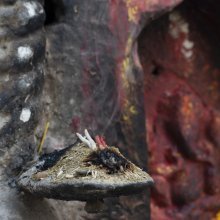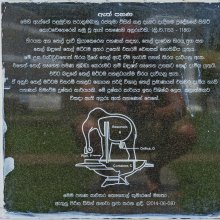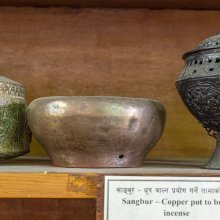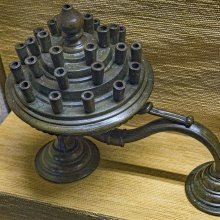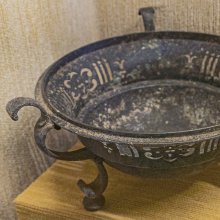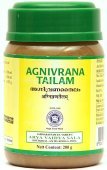Burning, Burn, Burned, Burnt: 3 definitions
Introduction:
Burning means something in Hinduism, Sanskrit, Jainism, Prakrit, the history of ancient India. If you want to know the exact meaning, history, etymology or English translation of this term then check out the descriptions on this page. Add your comment or reference to a book if you want to contribute to this summary article.
Images (photo gallery)
(+4 more images available)
In Hinduism
Yoga (school of philosophy)
Source: ORA: Amanaska (king of all yogas): A Critical Edition and Annotated Translation by Jason BirchThe Burning (of cow-dung) is denoted by the Sanskrit term Gomaya, according to the Haṭhapradīpikā 3.90.—Accordingly, “Pure ashes, which were produced by burning (dagdha) cow-dung, [should first be] placed in water. After having sex in which Vajrolī Mudrā [was performed], the woman and man, who are sitting comfortably and have finished love making, [should] immediately smear their own bodies [with the ashes mixed with water]

Yoga is originally considered a branch of Hindu philosophy (astika), but both ancient and modern Yoga combine the physical, mental and spiritual. Yoga teaches various physical techniques also known as āsanas (postures), used for various purposes (eg., meditation, contemplation, relaxation).
In Jainism
General definition (in Jainism)
Source: ORA: Amanaska (king of all yogas): (Jainism)The Burning (of the body) is denoted by the Sanskrit term Pluṣṭa, according to verse 12.42 of Hemacandra’s Yogaśāstra.—Accordingly, “At the time of the arising of the no-mind state, the Yogin experiences the body, which is as though it does not exist, as though [it were] separated, burned (pluṣṭa), flying up and dissolved”.

Jainism is an Indian religion of Dharma whose doctrine revolves around harmlessness (ahimsa) towards every living being. The two major branches (Digambara and Svetambara) of Jainism stimulate self-control (or, shramana, ‘self-reliance’) and spiritual development through a path of peace for the soul to progess to the ultimate goal.
India history and geography
Source: Singhi Jain Series: Ratnaprabha-suri’s Kuvalayamala-katha (history)1) Burning (of incense pots) formed part of the tasks performed to beautify the Sleeping chamber (of young ladies) in Ancient India, as depicted in the Kathās (narrative poems) such as Uddyotanasūri in his 8th-century Kuvalayamālā (a Prakrit Campū, similar to Kāvya poetry).—The Kuvalayamala (779 A.D.) is full of cultural material which gains in value because of the firm date of its composition. [...] Page 83.3-9: Here is the description of the house or the sleeping chambers of young ladies which were beautified for the reception of their husbands. The select items in this list are as follows: [e.g., burning of incense pots;] [...]
2) Burning (causing suffering) represents a scene of human life commonly depicted on the Saṃsāracakra paintings in ancient India, according to the Kuvalayamālā.—Page 185.21 f.: Here follows a description of a printed scroll illustrating the Jaina conception of saṃsāracakra. [...] The saṃsāra-cakra illustrated the three worlds of hell, human world and the world of gods. [For example:] People suffering from many kinds of diseases like fever, pain and burning, and lying on their cots and meeting their deaths, to gather their mourning servants, wives and friends

The history of India traces the identification of countries, villages, towns and other regions of India, as well as mythology, zoology, royal dynasties, rulers, tribes, local festivities and traditions and regional languages. Ancient India enjoyed religious freedom and encourages the path of Dharma, a concept common to Buddhism, Hinduism, and Jainism.
See also (Relevant definitions)
Starts with: Burning bush, Burning bush combretum, Burning Lamp Buddha, Burning love, Burning sensation, Cremation ground.
Full-text (+4302): Daha, Dahana, Dagdha, Jvalana, Dah, Dahaka, Plushta, Osha, Jvala, Plosha, Tapana, Vidagdha, Jalapola, Shantihoma, Jalana, Nirdagdha, Ushita, Pradah, Prajvalita, Prajvalana.
Relevant text
Search found 426 books and stories containing Burning, Burn, Burned, Burnt; (plurals include: Burnings, Burns, Burneds, Burnts). You can also click to the full overview containing English textual excerpts. Below are direct links for the most relevant articles:
Sushruta Samhita, volume 1: Sutrasthana (by Kaviraj Kunja Lal Bhishagratna)
Puranic encyclopaedia (by Vettam Mani)
Dhammapada (Illustrated) (by Ven. Weagoda Sarada Maha Thero)
Verse 136 - The Story of the Boa Constrictor Peta-Ghost < [Chapter 10 - Daṇḍa Vagga (Punishment)]
Verse 17 - The Story of Devadatta < [Chapter 1 - Yamaka Vagga (Twin Verses)]
Verse 251 - The Story of Five Lay-Disciples < [Chapter 18 - Mala Vagga (Impurities)]
Yoga Vasistha [English], Volume 1-4 (by Vihari-Lala Mitra)
Chapter LXXV - Description of the final conflagration of the world < [Book VII - Nirvana prakarana part 2 (nirvana prakarana)]
Chapter XCII - The prince's abjuration of his asceticism < [Book VI - Nirvana prakarana part 1 (nirvana prakarana)]
Chapter CXLI - Description of the termination of a kalpa-period < [Book VII - Nirvana prakarana part 2 (nirvana prakarana)]
The Jataka tales [English], Volume 1-6 (by Robert Chalmers)
Jataka 166: Upasāḷha-jātaka < [Book II - Dukanipāta]
Jataka 240: Mahāpiṅgala-jātaka < [Book II - Dukanipāta]
Jataka 133: Ghatāsana-jātaka < [Book I - Ekanipāta]
The Tattvasangraha [with commentary] (by Ganganatha Jha)
Verse 243 < [Chapter 7 - Doctrine of the Self (ātman, ‘soul’)]
Verse 879 < [Chapter 16 - Examination of the Import of Words]
Verse 2007 < [Chapter 23 - External World]
Related products
(+86 more products available)
